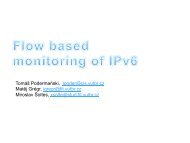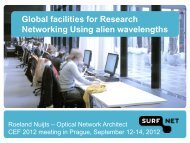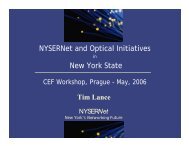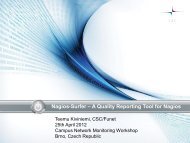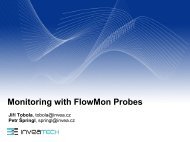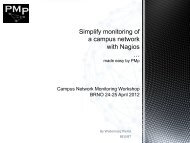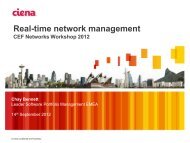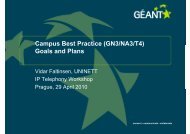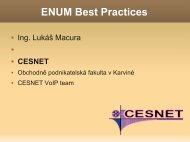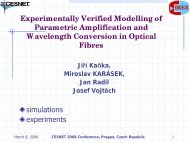2002 - cesnet
2002 - cesnet
2002 - cesnet
You also want an ePaper? Increase the reach of your titles
YUMPU automatically turns print PDFs into web optimized ePapers that Google loves.
lize all basic types of multimedia elements (text, still graphics and photographs,spoken comments, accompanying music, animations illustrating functionalprinciples, combined animation, video sequences). Later on, we completed thismultimedia program and tested it on a small sample of students. After severalminor flaws had been removed and certain elements added, we prepared theprogram for its further, wider use.The initial analysis, which dealt with the identification of didactic forms suitablefor the distance learning, resulted in the conclusion that the form of “the conservationof live university lectures” and their subsequent reproduction fromvideo cassettes or their distribution via telecommunication network has beenused very rarely so far.As a pilot example of this form – an audiovisual record of a university lecture– we chose the topic entitled SDH Transmission Systems, which may be usefulin the specialized part of the study at the Faculty of Electrical Engineering.We designed an outline and scenario of this specialized lecture and performedpreliminary recording tests for a part of the scenario in the real environmentof an occupied lecture hall at the faculty. After evaluating flaws of the testingrecord control, we recorded the complete lecture using a digital video camera.The recording is now prepared in the form of streamed video data to be storedon the multimedia server.Furthermore, we gathered the electronic education materials that had been createdin the previous years. Based on the technical and content analysis of thesematerials, we chose a set of programs that could be integrated into the distancelearning system in environments of technical universities (or high schools aswell). Special attention was paid to the category of programs that could be usedwithin the existing or future teaching in the environment of our department.Testing of both newly created and older multimedia programs with the participationof students were carried out both in regular courses and in the Researchand Development Centre for Mobile Communications (RDC – joint project ofOSKAR, Ericsson and CTU).Within the project, we also assessed the possibilities of using the WebCT didacticplatform for online education support. Specifically, we tested capabilities of thisdidactic platform with the SHPW training and examination. We concluded thatthe WebCT system is not suitable for the given purpose. The reasons include:the system is proprietary, more or less closed, with its own user identification;possibilities for employing multimedia elements are limited; the evaluation apparatusfor knowledge testing does not meet our needs; for the given purpose,solutions based on open platforms seem to be more appropriate.In order to improve the quality of the acquisition stage of the supportive educationmaterials preparation, we completed the current configuration with amultimedia workstation and a mobile workplace for transmission of the videosequences over LAN and wireless LAN.154 High-speed National Research Network and its New Applications <strong>2002</strong>



